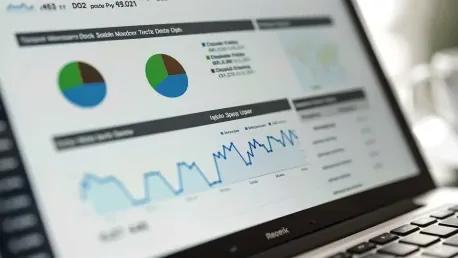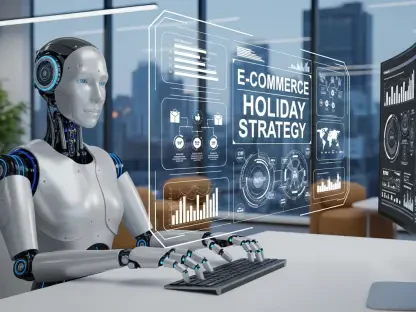The retail industry is undergoing a technological revolution, driven by the adoption of the Internet of Things (IoT). This transformation offers innovative solutions to enhance customer experiences and streamline operations. By 2032, the IoT in retail market is forecasted to skyrocket to USD 296.67 billion from just USD 51.56 billion in 2023, growing at a compounded annual growth rate (CAGR) of 28.4%. Here’s how IoT is poised to sculpt the future of retail.
The Expansive Growth of IoT in Retail
Market Projections and Driving Forces
As technology continues to evolve, the IoT in retail market is expected to witness unprecedented growth. Companies are investing heavily in research and development to innovate and improve their offerings. Real-time data collection is a staple of IoT, providing invaluable insights into stock levels, customer preferences, and sales trends. This data helps retailers enhance both functionality and customer experience, potentially redefining the traditional shopping landscape.
The significant rise in market value from USD 51.56 billion in 2023 to an impressive USD 296.67 billion by 2032 highlights not just growth but transformation, driven by technological advancements and strategic investments. This transformation will enable retailers to make data-driven decisions, optimize their operations, and provide a more personalized shopping experience, ultimately fostering brand loyalty and increasing sales.
Technological Advancements Enhancing Retail
Technological innovations in IoT are transforming traditional retail operations. Smart shelves equipped with sensors can track inventory in real-time, alerting staff to restock products and avoiding out-of-stock situations that frustrate customers. The deployment of cashier-less stores is another game-changer. Using sensors and cameras, these stores offer a seamless shopping experience where customers simply pick products and leave, with transactions completed automatically via their mobile apps.
This evolution towards automation not only enhances customer satisfaction but also frees up staff to focus on other critical tasks, such as customer service and store maintenance. The result is an efficient, streamlined operation that reduces overhead costs and boosts profitability. Additionally, by minimizing the need for human intervention, IoT technologies help mitigate errors and ensure a more accurate reflection of inventory and pricing.
The Role of Data Analytics in Retail
Data analytics powered by IoT is revolutionizing retail by enabling more accurate demand forecasting and inventory management. Retailers can now predict trends and customer behavior with higher precision, helping them to customize offerings and marketing strategies. Increased demand for data analytics tools is pushing retailers to adopt IoT, as these insights allow for better decision-making and strategic planning. This trend is pushing the industry towards more data-driven operations and away from intuition-based decisions.
Moreover, data analytics offers retailers the ability to segment their customer base more effectively, tailoring promotions and product recommendations to individual needs. This personalized approach not only caters to modern consumer expectations but also drives higher conversion rates. By leveraging IoT-driven analytics, retailers can achieve a competitive edge, responding swiftly to market changes and customer demands, ultimately fostering sustained growth and profitability.
Enhancing Customer Experience Through IoT
Personalized Marketing and Smart Fitting Rooms
One of the standout advantages of IoT in retail is its ability to deliver personalized marketing. Leveraging data from connected devices, retailers can offer customized promotions and product recommendations, enhancing customer satisfaction and loyalty. Smart fitting rooms are another innovative application. These rooms use IoT to provide personalized fitting information, helping customers make better purchasing decisions and improving their overall shopping experience.
Smart fitting rooms can recommend products based on previous purchases or preferences, creating a seamless blend of online and offline shopping. This integration not only elevates the shopping experience but also provides retailers with data to refine their offerings continually. By meeting customers’ unique needs through personalized interactions, retailers can deepen relationships, increase repeat business, and grow their customer base.
Streamlined Operations and Efficiency
IoT technologies also promise to streamline various retail operations. Automated inventory tracking reduces human error and ensures that shelves are always stocked. By providing real-time data on product movements and sales, IoT helps in optimizing supply chains and reducing operational costs. This efficiency allows retailers to focus more on customer service and less on back-end logistics.
Through predictive maintenance and remote monitoring, IoT can also prolong the lifespan of retail equipment, minimizing downtime and repair costs. Automating routine tasks like inventory management and checkout processes can significantly enhance operational efficiency, enabling staff to prioritize customer engagement. The cumulative effect of these advancements is a more resilient and agile retail operation, capable of adapting to market trends and customer needs with greater agility.
Case Studies of Successful Implementation
Several major retailers are already reaping the benefits of IoT. For example, Amazon Go stores have implemented cashier-less technology, setting a new standard for convenience and efficiency. Other retailers are using IoT for better inventory management, leading to significant cost savings and increased customer satisfaction. These case studies serve as a testament to the transformative power of IoT in retail.
Retail giants such as Walmart and Target have also been early adopters of IoT technologies, leveraging connected devices for optimized supply chain management and enhanced in-store experiences. By capitalizing on the operational insights and customer data provided by IoT, these companies have successfully navigated the challenges of modern retail, setting a precedent for smaller retailers to follow. The widespread adoption of IoT solutions signifies a paradigm shift in how retail businesses operate, emphasizing data-driven strategies and customer-centric practices.
Challenges and R&D Investments
Data Security and Privacy Concerns
While IoT offers numerous benefits, it also presents challenges, particularly in data security and privacy. With the increasing amount of data being collected, the risk of breaches and misuse escalates. Retailers need to invest in robust security measures to protect customer data, which involves not just technology but also training staff to manage and safeguard sensitive information effectively.
Implementing encryption protocols, multi-factor authentication, and regular security audits are essential steps in fortifying data security. Retailers must also stay compliant with data protection regulations such as GDPR and CCPA, ensuring that customer data is handled transparently and ethically. Failure to address these concerns can result in reputational damage and financial penalties, underlining the importance of prioritizing data security in the IoT expansion.
High Investment Costs
The initial costs of implementing IoT solutions can be prohibitive for some retailers. These investments include not only the technology itself but also the infrastructure and training needed to use these systems effectively. Despite these costs, the long-term benefits, such as increased operational efficiency and improved customer experiences, make IoT a worthwhile investment for forward-thinking retailers.
To mitigate the financial burden, retailers can explore phased implementation strategies or seek partnerships with tech providers offering scalable solutions. Government grants and industry incentives may also be available to support digital transformation initiatives. By strategically planning IoT investments and leveraging financial aids, retailers can overcome the initial cost barrier and unlock the substantial benefits of IoT-driven operations.
Future Trends and Opportunities
Looking ahead, the integration of artificial intelligence (AI) with IoT will open new doors for predictive analytics and enhanced customer engagement. These technologies will enable even more precise demand forecasting and personalized marketing. Improved supply chain management through IoT will also become more prevalent, helping retailers to reduce costs and improve delivery times. The ongoing investment in IoT and AI promises a future where retail operations are more efficient and customer-centric than ever before.
As AI algorithms become more sophisticated, the synergy between IoT and AI will offer predictive analytics capabilities that can anticipate market trends and customer preferences with remarkable accuracy. This foresight will empower retailers to make proactive decisions, optimizing everything from inventory management to marketing campaigns. Additionally, the integration of IoT with blockchain technology may enhance supply chain transparency and traceability, further bolstering consumer trust and operational efficiency.
Key Players and Geographical Markets
Major Companies Driving the Market
Several key players are spearheading the IoT in retail revolution, including Arm Ltd., Cisco Systems, and Google LLC, among others. These companies are pioneering innovations that are making it easier for retailers to adopt IoT technologies. IBM Corp. and Intel Corp. are providing powerful data analytics tools, while Microsoft’s cloud solutions are facilitating seamless integration. Losant IoT and NXP Semiconductors are also notable contributors, offering specialized products to optimize retail operations.
The extensive involvement of these industry giants underscores the importance of IoT in the future retail landscape. By leveraging their expertise and resources, these companies are not only advancing technological capabilities but also setting industry standards. Their collaborative efforts are crucial in overcoming the challenges associated with IoT implementation, paving the way for smoother adoption across the retail sector and ensuring that even smaller players can benefit from these transformative technologies.
Geographical Markets Driving Growth
The retail industry is experiencing a technological revolution fueled by the Internet of Things (IoT). This shift is bringing about innovative solutions to improve customer experiences and streamline operations. By 2032, the IoT in retail market is projected to soar to USD 296.67 billion, a significant jump from USD 51.56 billion in 2023, with a compounded annual growth rate (CAGR) of 28.4%.
IoT technology in retail can offer numerous benefits, such as enhanced inventory management through real-time tracking and automated restocking. Smart shelves can alert staff when products are running low or misplaced. Additionally, IoT-enabled devices can personalize the shopping experience by gathering data on customer preferences and suggesting products accordingly. Security can also be improved through smart cameras and sensors that detect suspicious activities.
Furthermore, IoT can optimize energy consumption in stores by controlling lighting, heating, and cooling systems based on foot traffic. As this technology continues to evolve, it is poised to shape the future of retail, providing a more efficient and engaging shopping experience.









